Photo AlbumWhen I'm tying at fly fishing shows and conclaves I'm often asked if I only tie and fish warmwater flies. Even though my first love is warmwater angling, I enjoy trout fishing as well. In fact, I plan to fish as many trout streams and rivers as possible as long as it doesn't get in the way of my pursuit of bass, pike, and panfish. Here are some of my photo memories of those streams and the fish that live in them. 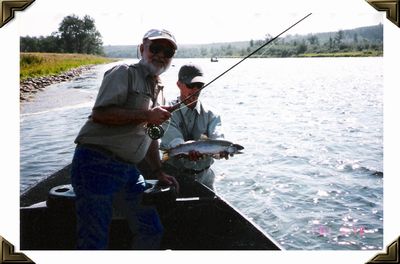
Canada's Bow River - Summer, 2001 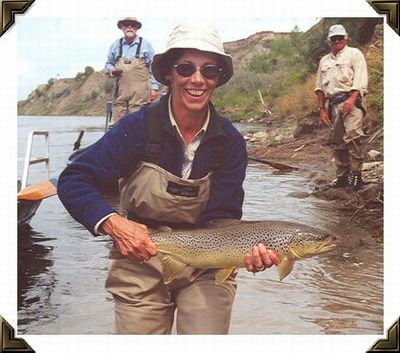
Jean Pickles' 24 inch Bow River Brown Trout 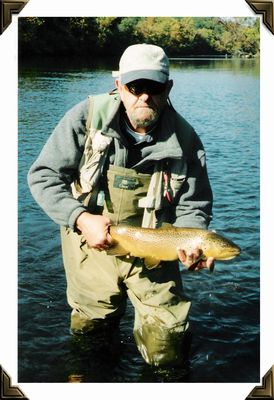
Northfork River Arkkansas - Brown - Fall, 2001 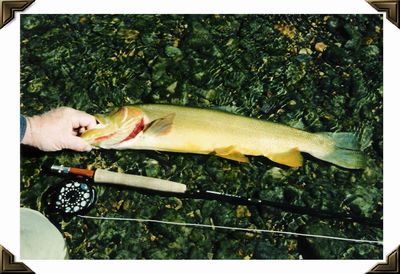
Northfork River Arkansas - Cutthroat - Fall, 2001 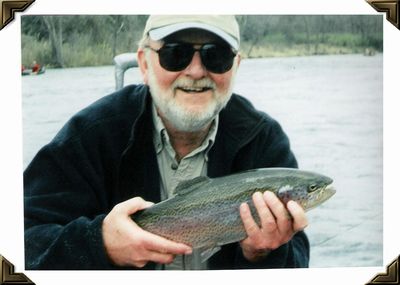
Northfork River Arkansas - Rainbow - Spring, 2002 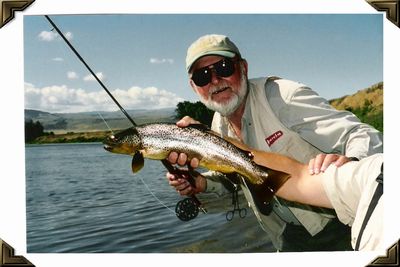
Bighorn River Wyoming - Rainbow - Summer, 2002 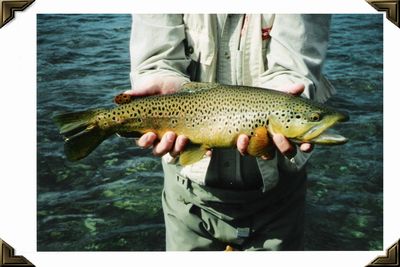
Bighorn River Wyoming - Brown, Summer, 2002 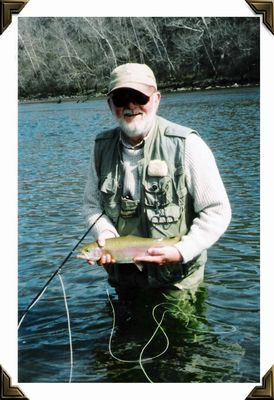
Northfork River Arkansas - Rainbow - Fall, 2002 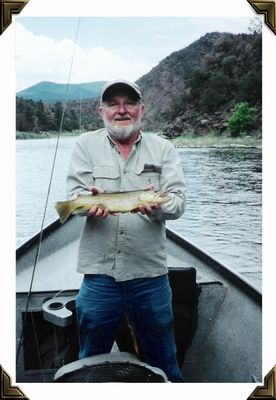
Green River Utah - Brown - Spring 2003 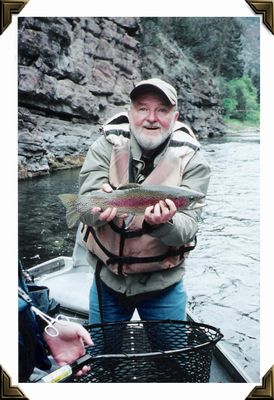
Green River Utah - Rainbow - Spring, 2003 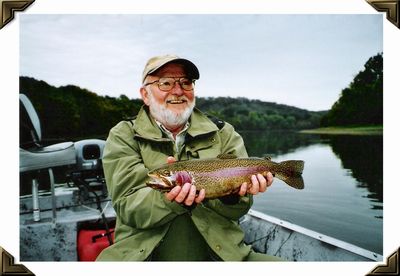
White River Arkansas - Rainbow - Fall, 2003 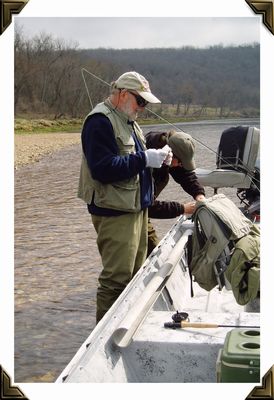
Ready for a day on the water. White River, Arkansas 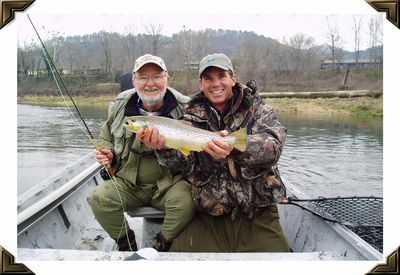
White River Arkansas Brown - Spring, 2004 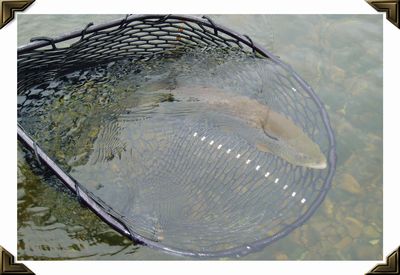
Nice Trout 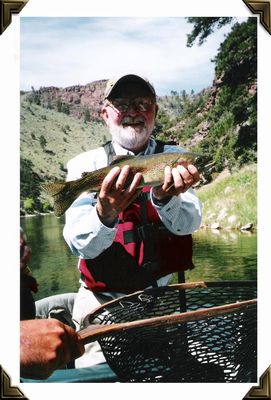
Green River Utah - Rainbow - Spring, 2004 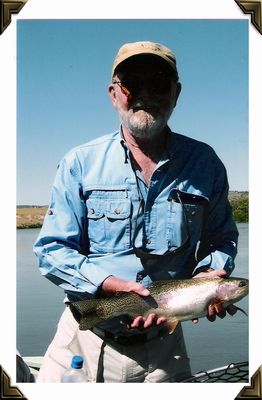
North Platte River Wyoming - Rainbow - Summer, 2004 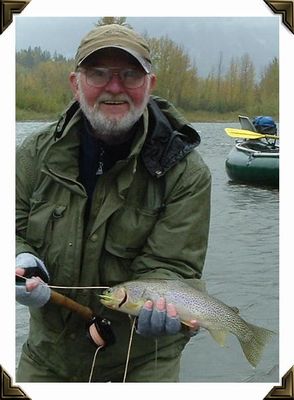
Elk River British Columbia - West Slope Cutthroat - Fall, 2004 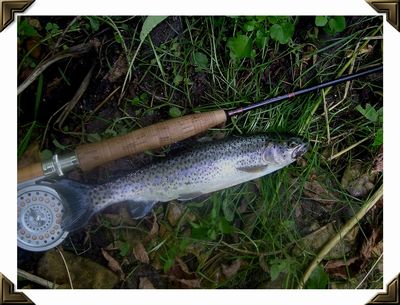
Typical Rainbow - Trout River - Winneshiek County, Iowa - August, 2005 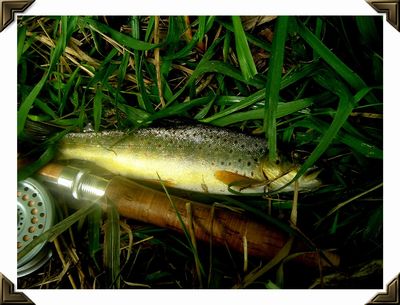
Stream born Brown Trout - Waterloo Creek - Allamakee County, Iowa - August, 2005 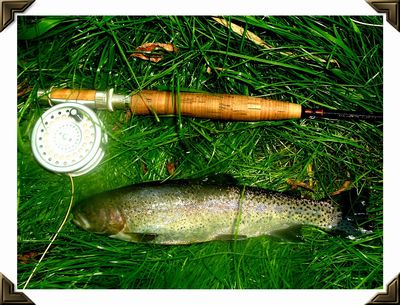
Spring Creek trout are great fun on a 3-wt. rod. Utah's Green River - June, 2006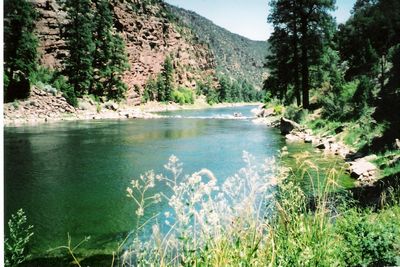
The Beautiful Green River below Flaming Gorge Dam 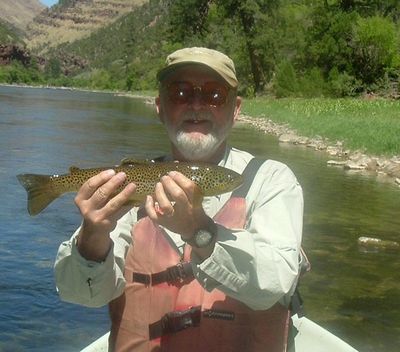
A typical Green River Brown Trout 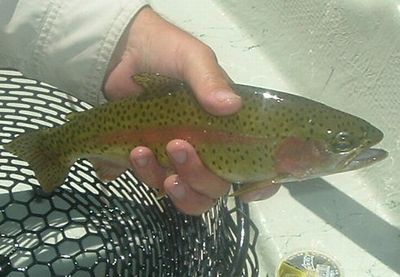
Green River Rainbows are as pretty as the river. 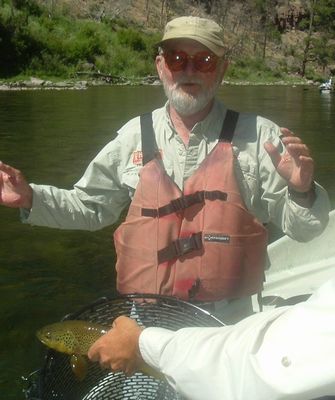
He felt like he was that big. 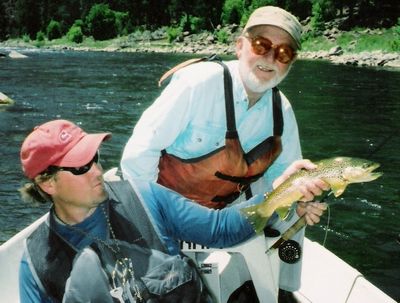
Another nice looking Green River Brown Trout, 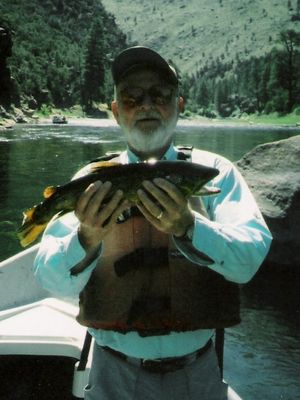
This trout is missing part of his tail. The work of a River Otter. Wisconsin's Manitowoc River - November 2007Late in the fall after the smallmouth and other warmwater gamefish are hunkered down for the winter it's time to head north for the brown trout, chinook, and caho runs out of Lake Michigan. Because of low water in October we missed the salmon runs but in November the river levels rose and we were able to get into some river run brown trout. 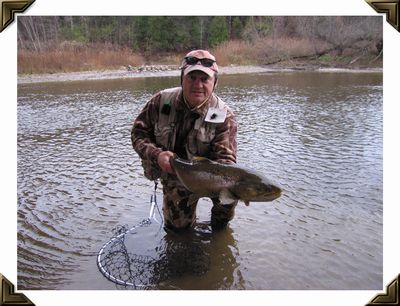 My friend Mike Jacobs about to release a 30-inch Manitowoc River brown trout. 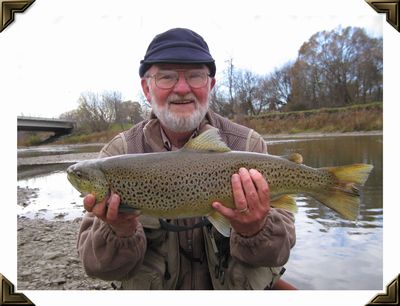 This 25-inch brown is typical of the brown trout that migrate up Wisconsin's Manitowoc River in the fall. 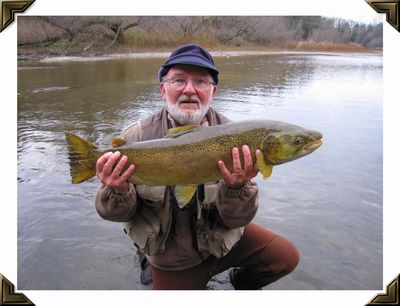 A nice 30-inch brown from the Manitowoc River in southeastern Wisconsin. Colorado Fishing Adventure - Autumn 2008Over the years I have had the good fortune to fish for trout in many of the western states including Wyoming, Montana, Idaho, Utah, and British Columbia but I had never fly fished in Colorado until this fall. When my friend and smallmouth fishing companion Mike Jacobs invited my wife Parker and me to join him and his wife Carol and friends Doug and Pat Nauman for a ten-day adventure in the Colorado wilderness I readily accepted. Parker, whose idea of a fishing trip is to spend her time in the comfort of a Holiday Inn looking at the mountains, decided to stay home. I was the odd man out. 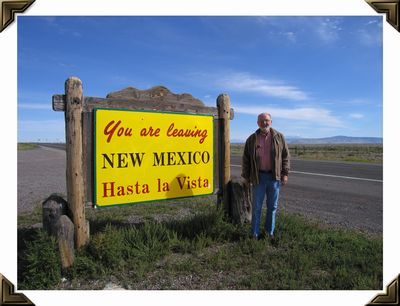 Mike's plan was for us to begin on the New Mexico border and work our way north in pursuit of Colorado's three native species of cutthroat trout - The Rio Grande, The Greenback, and The Colorado River strains. In addition we were going to try our luck on Kokanee Salmon near Gunnison, Colorado and Artic Grayling further north near the Wyoming border. 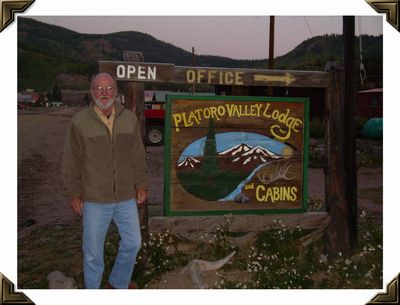 We started our adventure in the San Juan Wilderness twenty miles north of Platoro, Colorado. Our base camp for the next three days was the Platoro Valley Lodge which is well above ten thousand feet elevation. 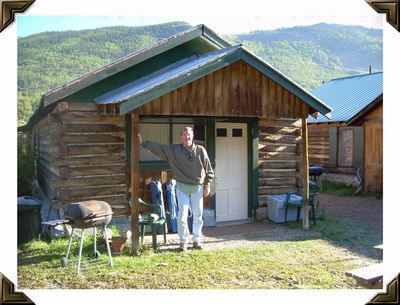 Our cabin at the Platoro Valley Lodge was quaint but comfortable with running water, bath, and a kitchen. However, we didn't have radio or TV and we never could get a signal on our cell phones while we were there. The other cabins were occupied by Elk hunters, mostly from Texas. We were the only anglers in camp. 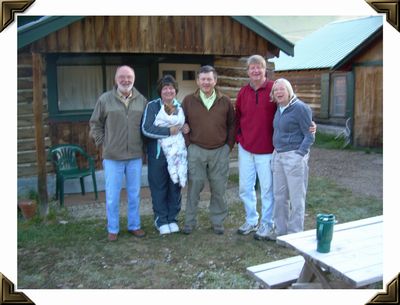 I forgot to mention earlier that Mike and Carol also brought along their baby boy "Beamer", a Chihuahua, who was constantly wrapped in his "blankie" to fend off the cold. 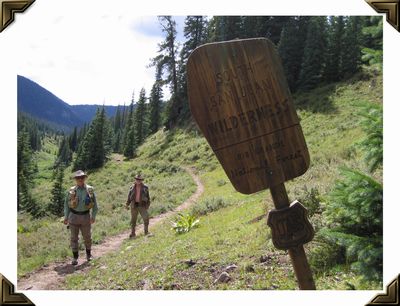 Our first attempt to locate the Rio Grande Cutthroat was on the Middle Fork above Platoro Reservior in the San Juan Wilderness area of the Rio Grande National Forest. Here you see Doug and myself comming out of the Middle Fork. We had no luck finding trout. The Middle Fork is one of the streams that flow into the Platoro Reservior. The outlet of the Reservior forms the Coneojos, a well known southern Colorado trout stream. 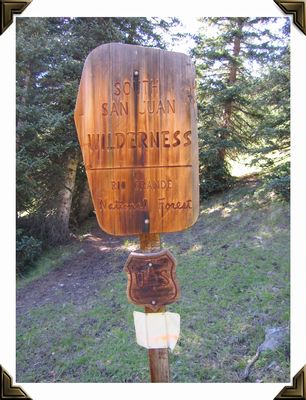 After our failure to find trout on the Middle Fork, Mike and Doug decided to spend the next two days exploring the Adam's Fork and the Lake Fork, two other cutthroat streams in the Conejos river drainage. Because of the high altitude, between eleven and twelve-thousand feet, as well as the steep terrain I decided to stay in camp. The hike into the Middle Fork proved to me that almost seventy years of riotous living had finally caught up with me. 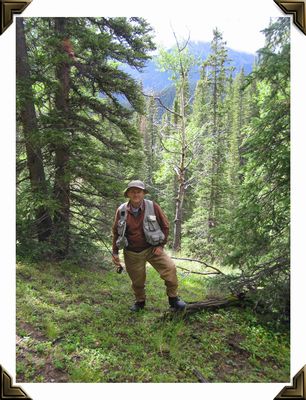 Mike Jacobs on the trail into the Adams Fork. According to Mike I would have had a tough time with the hike up to the stream. 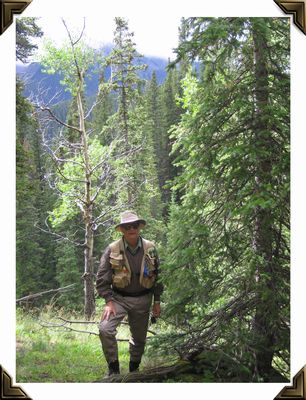 Doug took a photo of Mike and Mike did the same for Doug. Your's truly was back in camp with the girls breathing a hell of a lot better than if I had been with those two guys. 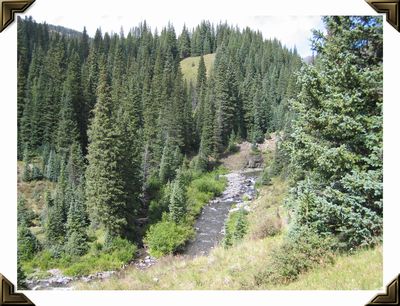 Here is the Adam's Fork. You can easily see why I stayed in camp. 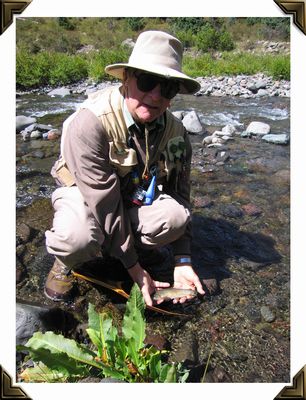 Doug with the first Rio Grande Cutt after the long hike into the Adams Fork. 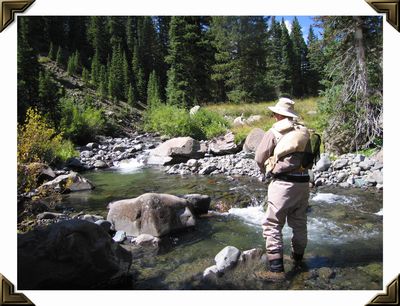 Doug casting to another fish on the Adam's Fork. Mike took most of the photos on that outing. 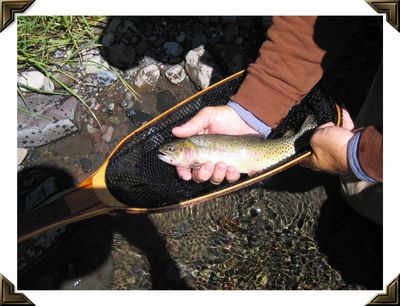 This is Mike's first Rio Grande Cutt. This little guy is one of just a few Rio Grande Cutthroat trout that remain in Colorado. It's current range has been reduced to about one-per cent of it's original range in southern Colorado. New Mexico's population is limited as well. 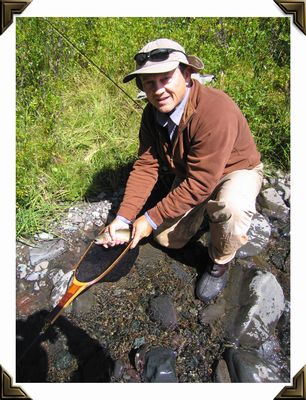 The Rio Grande Cutthroat was the main reason Mike wanted to make this trip. On previous trips to Colorado he had taken the other two species - the Greenback and the Colorado River strains. 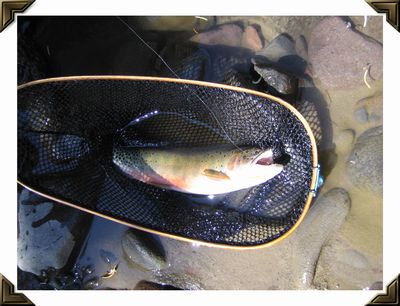 Another nice Rio Grande Cutt taken by Mike. The fish ranged in size from eight to twelve inches. 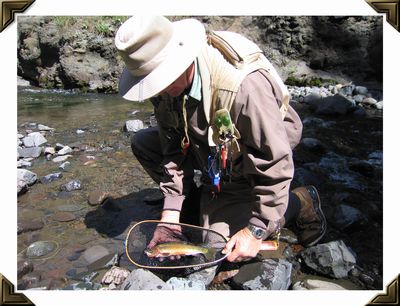 Doug with another Rio Grande Cutt. 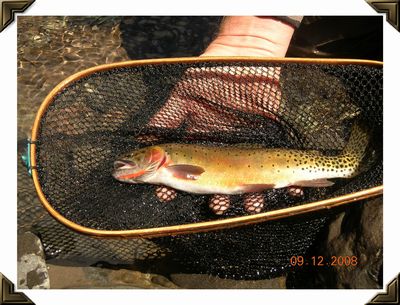 Another nice photo of a Rio Grande Cutt. Rio Grande Cutthroats are much more colorful than the Greenback or Colorado River strains. 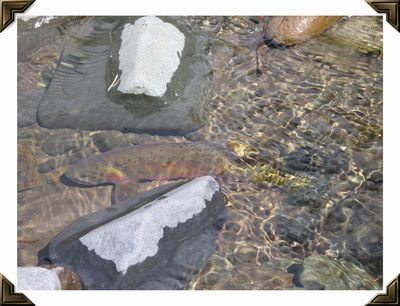 This is the same fish resting after being released unharmed. All of the trout during the trip were caught on dry flies, size sixteen and smaller. Colorado regulations limit fishing for these beautiful little fish to artificials only and all fish must be returned to the stream 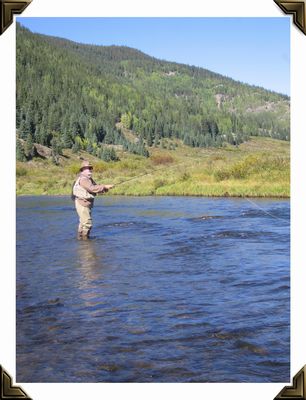 The following morning we fished below our camp on the Conejos with no luck. We also explored some smaller streams in the area to no avail. In the afternoon Mike and Doug hiked into the Lake Fork above Rock Lake Reservior for more Rio Grande Cutts. 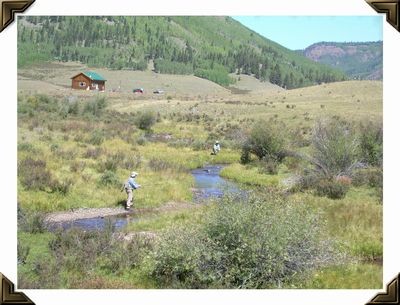 Here is a shot of Mike and Doug exploring one of the smaller streams in the morning. 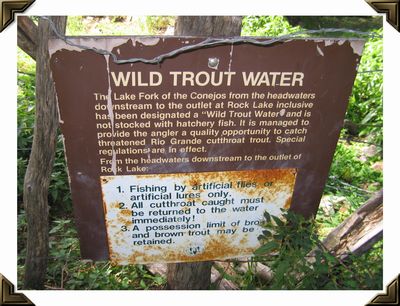 The guys took the old man back to camp and spent the afternoon hiking back into the Lake Fork. 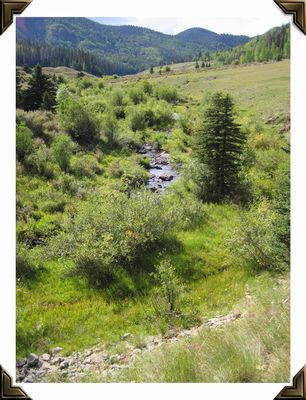 Lake Fork in the distance. It was about a three mile trek back into the stream. 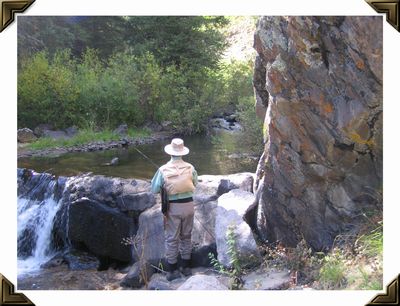 Doug fishing a pool above a small dam on Lake Fork. 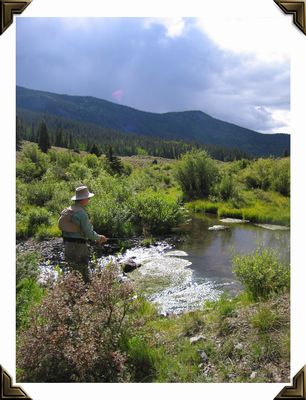 This is a typical pool on the Lake Fork. Not big water but big enough to hold cutts. 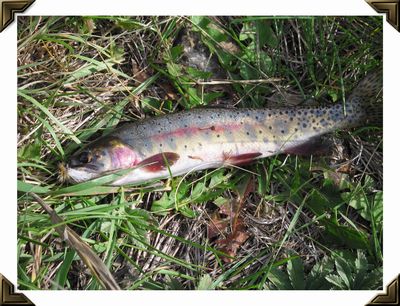 Here is the Rio Grande Cutthroat that lived there. 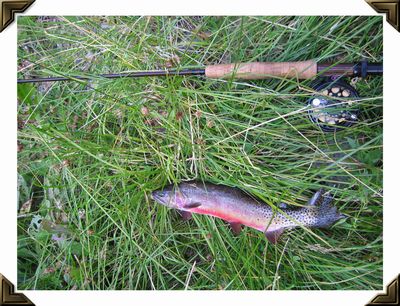 Mike and Doug caught several cutts like this one during their afternoon on the Lake Fork. 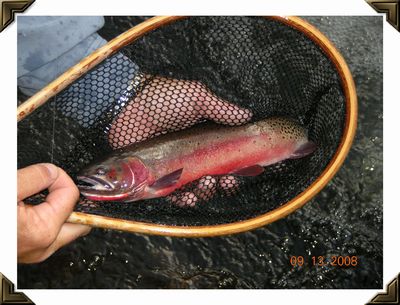 Another great photo of these brightly colored cutts. The fish on the Lake Fork were much more brightly colored than the fish on the Adam's Fork. Click on the photo for a better view. 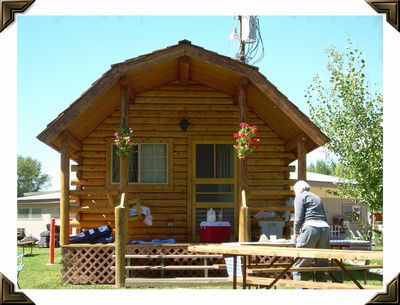 The next leg of our trip was Gunnison, Colorado where we planned to spend a couple of days fishing for Kokanee Salmon on the East River. Hear Doug's wife Pat prepares lunch at our cabin at the KOA campground in Gunnison. It's a beautiful KOA with trout ponds on and near the property. Very civilized compared to our camp at Platoro. 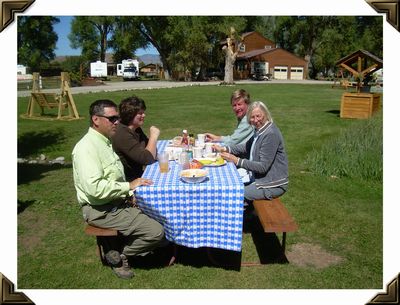 And here we are eating lunch before Mike, Doug, and I head out for some Kokanee fishing. The elevation in the Gunnison area is about seven thousand feet. What a difference a drop of three or four thousand feet in elevation has on the ability to breathe. 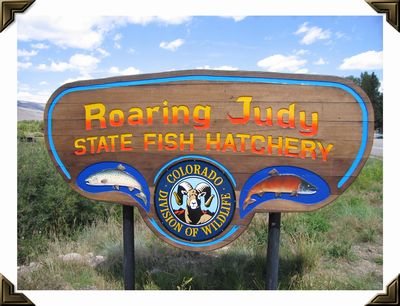 The Kokanee Salmon is the landlocked cousin of the Sockeye Salmon that lives in the Pacific Ocean and spawns in the streams of the Columbia River System, Canada, and Alaska. Landlocked Kokanee populations occur in the Yukon Territory, British Columbia, Alaska, Washington, Oregon, California, Utah, Idaho, Montana, Colorado, New Mexico, and Wyoming. Our plan was to fish for the Kokanee on the East River which flows through the Roaring Judy Fish Hatchery grounds which is about five miles above the small village of Almont, Colorado. The East River joins the Taylor River at the town of Almont to form the Gunnison River a few miles above the town of Gunnison, Colorado. Many anglers fish the junction of these two rivers but we opted for the East River. 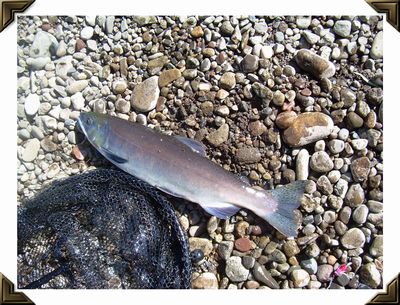 This is a good photo of a Kokanee Salmon that was caught in the East River on the 776 acre Roaring Judy Fish Hatchery grounds. During the fall spawning run both female and male Kokanee Salmon are taken from the stream by Roaring Judy Hatchery personnel and stripped of their eggs and milt. This happens at the same time that anglers are allowed to fish on the grounds. 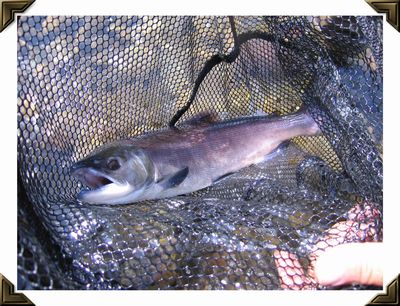 Kokanee Salmon fingerlings were first stocked in the East River at the hatchery more than twenty-five years ago. The fingerlings swam down river some thirty miles to the Blue Mesa Reservior were they spent three years reaching maturity before returning to the East River during fall spawning runs. And, that ritual has been happening every year since their introduction. Today, the hatchery typically spawns 20 to 30 thousand salmon to produce 7 million fertilized eggs. Those eggs are the future of the Kokanee fishery in the Blue Mesa Reservoir as well as other Colorado reserviors because Kokanee Salmon are not able to spawn naturally in Colorado streams. 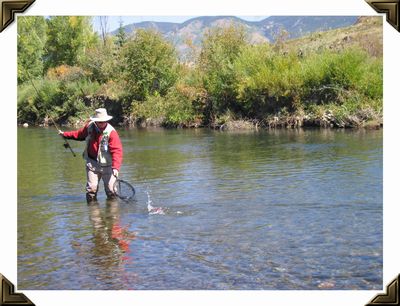 Here is Doug about to land a Kokanee in the East River on the hatchery grounds. The salmon began their spawning run as early as late July with the peak run occuring in Mid to late September. The spawing run is approximately 30 miles from Blue Mesa Reservior to the Roaring Judy Fish Hatchery - the longest spawing run in Colorado. 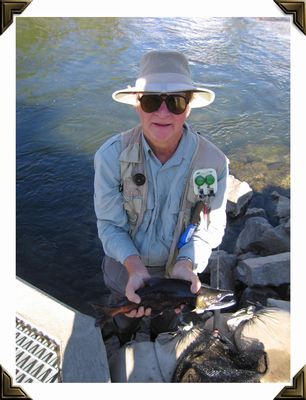 Doug with a nice male Kokanee. Notice the hooked jaw. 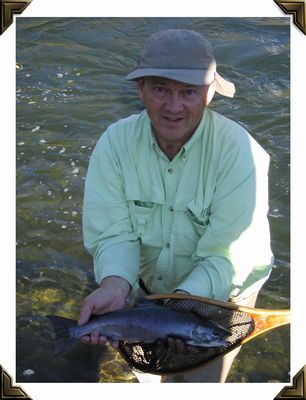 Mike with a nice male Kokanee. 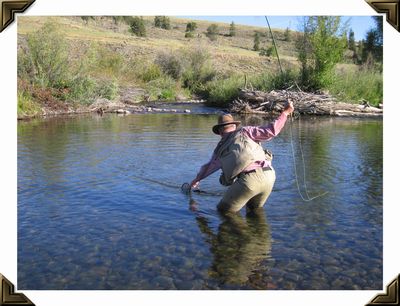 Your's truly about to net a beautiful Kokanee salmon. Nice butt shot by the way, don't you think? 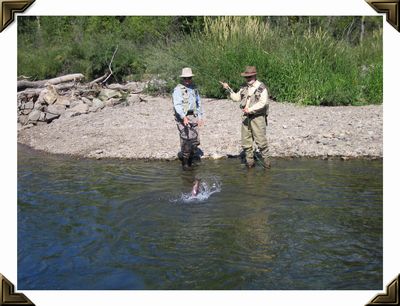 Doug ready to net my fish.  This is an average sized Kokanee. The fish we took ran up to eighteen inches. 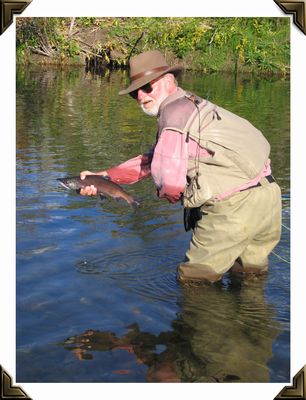 There were literally thousands of fish like this in the stream. 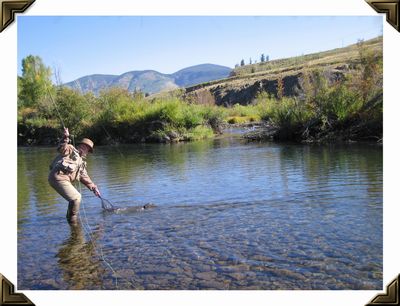 I suppose that this is the classic pose for landing a nice Kokanee. 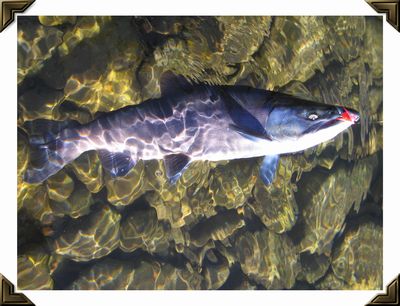 This is a great photo of a fish taken by Mike with the Kokanee in the water ready to have the lure removed from his jaw after a spirited fight. 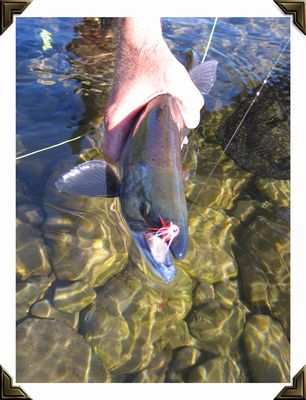 Another fish with the lure ready for removal. 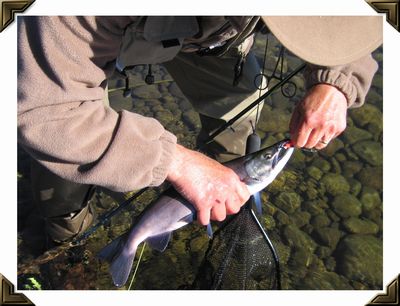 In two and one-half days of fishing we took well over one-hundred and fifty fish. We used two fishing rigs. Both set-ups used flies with red as part of the dressing. The fish seem to hate the color red. The first rig consisted of a fly with a dropper about a foot below the point fly. Both lures were brightly colored salmon/steelhead flies. The leader was about five-foot long with a couple of Twist-On lead weights to get the fly in the fishes face. This set-up would often foul-hook the fish in the tail or a fin as it drifted through a pod of fish. The second rig, the one we used the most, was a single fly on a four to five-foot leader with Twist-On lead to get the fly to the fish. We also used a new type of strike indicator about the size of a grape tomato at the point where the leader and line joined. When the indicator paused or bobbed you set the hook and the fish was on. This rig guaranteed a fair hooked fish almost every time. 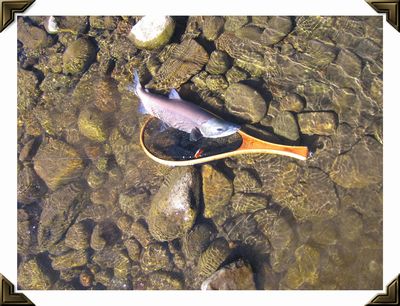 This photo belongs on a fly fishing magazine cover. Mike took the photo after the fish was released. Click on the photo for a larger view. You can see the fly that had just been removed from his jaw and is resting on the net. You couldn't ask for a more natural photo composition. Fish, fly, net, water, and rocks. 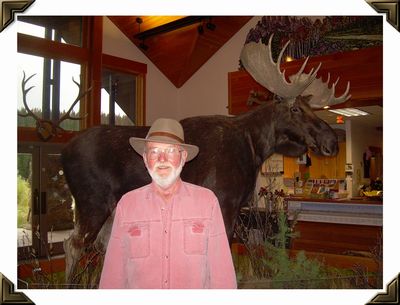 The last leg of our fishing adventure took us north and east of Gunnison to Gould, Colorado, again at an elevation over ten thousand feet and thin air. Gould is located near the North Park of the Rocky Mountain National Park. It's in the center of the Colorado Moose Restoration effort. We stayed at the Gould KOA campground which is a real wilderness camp as compared to the KOA in Gunnison. One of the first places we visited, the afternoon that we arrived, was the Moose Center located a couple of miles north of the campground. The camp was filled with Elk hunters and we heard Elk bugle throughout each night. It was a full moon and the hunters were not having very good luck. The Elk were up all night and bedding down during the day. 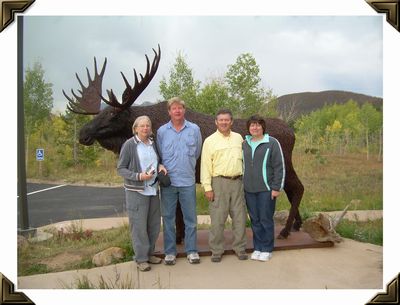 The "gang" posing with a moose sculpture outside the center. 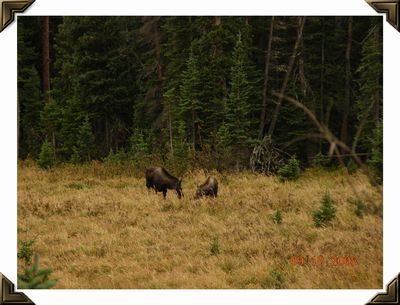 This photo of cow and her calf was taken by Mike and Doug on one of their fishing excursions into the back country. Several years ago the state of Colorado re-introduced Moose in their native habitat. The DNR planted eighteen Moose which since have grown into a heard of more than twenty-thousand animals in this area. We saw eleven moose during our stay, almost hitting one in the dark of the morning we left for home. Just as we left the campground we came upon a moose running along the right shoulder of the road. If he had decided to take a sharp left at the moment we saw him he would have been in the front seat with me. 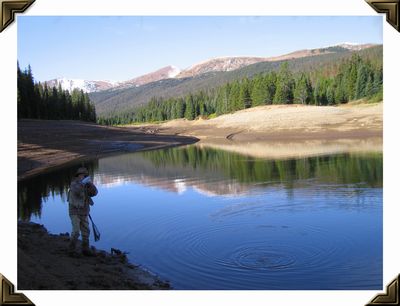 Our goal in the North Park area was to catch Artic Grayling, Greenback Cutthroat and Colorado River Cutthroat. The Grayling were located in Joe Wright Reservior and Joe Wright Creek, both located along highway 14 near Cameron Pass, a few miles above our camp. 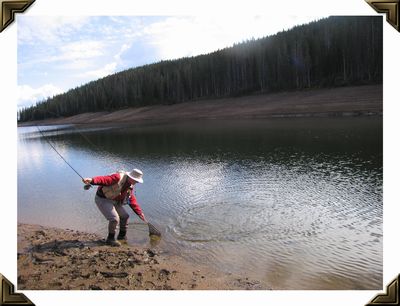 Here is Doug landing an Artic Grayling at Joe Wright Reservior.  The Grayling averaged around ten-inches, some up to a foot long. 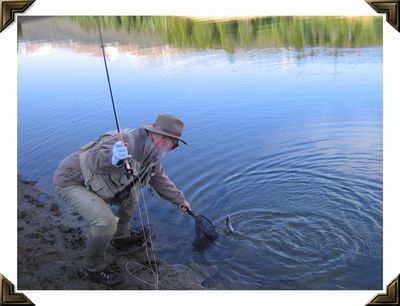 About to net my first Artic Grayling. 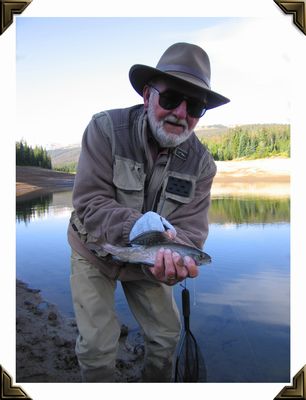 Click on the photo for a closer view. 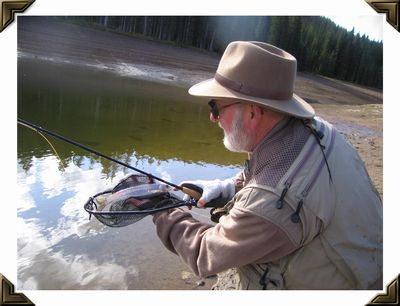 Grayling were first stocked in Colorado in the 1890's, but it wasn't until the mid-1960's that the Division of Wildlife had success with a self-sustaining population. 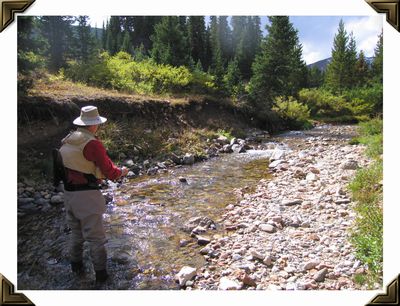 We also fished Joe Wright Creek for Grayling and Greenback Cutthroats. 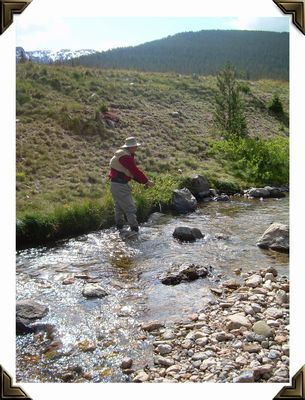 We fished Joe Wright Creek above Joe Wright Reservior. 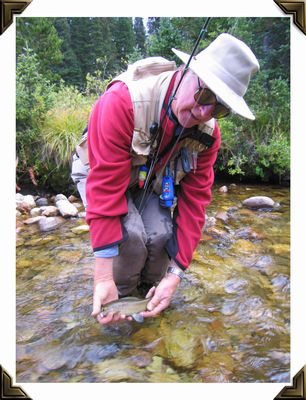 Doug Nauman with a Greenback Cutthroat from Joe Wright Creek. 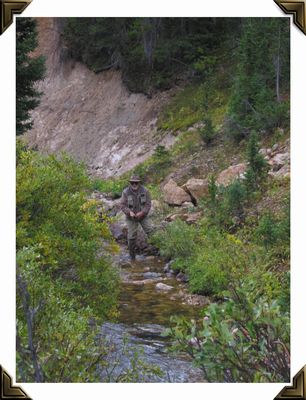 Both the creek and the reservior have populations of Grayling and Greenback Cutthroat Trout. 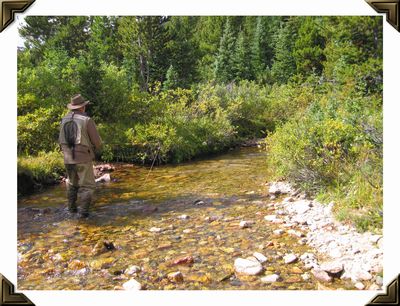 Another view of Joe Wright Creek. 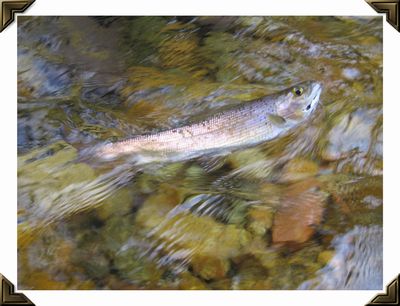 A nice photo of a Grayling from Joe Wright Creek. 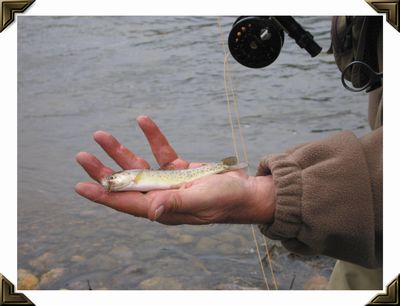 I had the honor of catching the smallest Greenback. 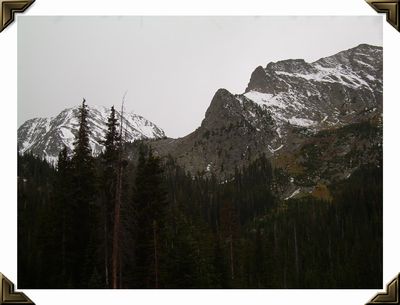 After catching Artic Grayling and Greenback Cutthroats on Joe Wright Reservior and Joe Wright Creek that morning we headed higher up to Long Draw Reservior to fish the outlet stream called LaPoudre Creek for Colorado River Cutts. The peaks were covered with snow. At one point it briefly snowed on us. 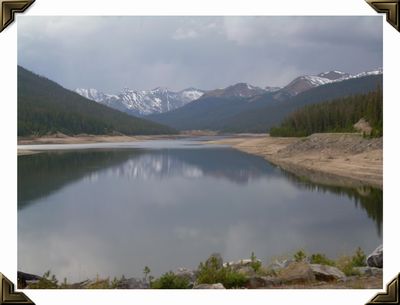 Here is Long Draw Reservior as it appears from the top of the earthen dam. 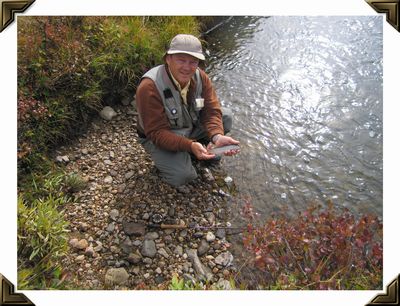 Mike Jacobs with a Colorado River Cutt from LaPoudre Creek. 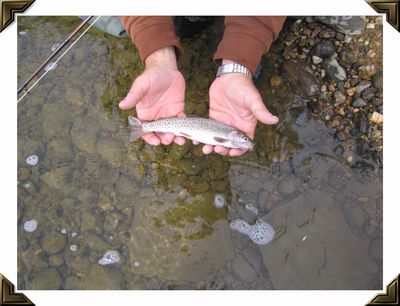 This was the averaged sized Colorado River Cutt taken from the creek. 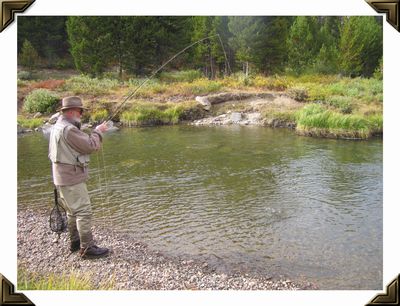 Catching my first Colorado River Cutthroat Trout. 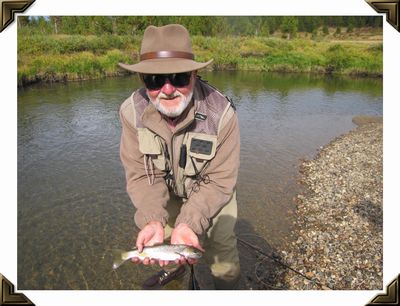 Actually the fish caught me. But that's a story for another time. 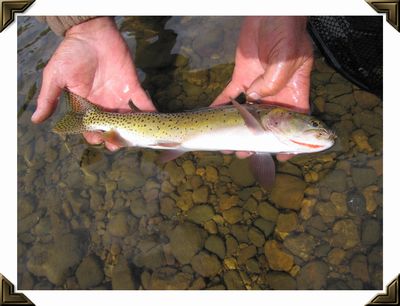 Be that as it may, it was a good sized and beautifully colored fish. 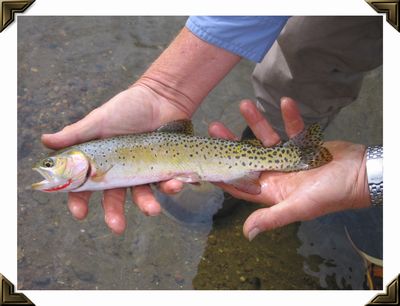 This is another Cutt taken by Doug Nauman. We also caught Brookies from LaPoudre Creek. 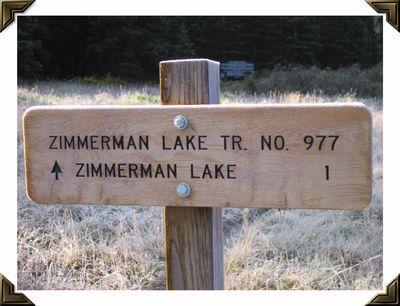 The following day Mike and Doug along with Doug's wife Pat trecked into Zimmerman Lake for some fishing for Greenbacks. I stayed in camp with Mike's wife Carol to begin packing for the trip home the following morning. The old man was afraid that he would have a cardiac arrest if he tried the long and steep walk into the lake. 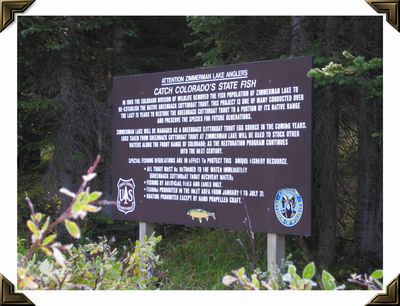 This sign indicates that all fish were removed from the lake in 1995 in order re-establish the native Greenback Cutthroat. The Colorado DNR now take eggs and milt from the resident fish in an effort to restablish the Greenback in its traditional range. 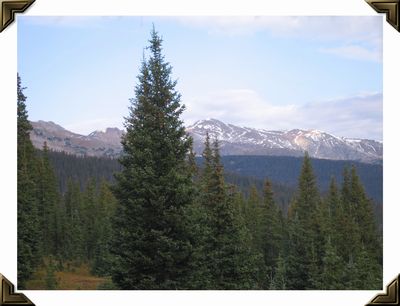 Here is a photo of the snow capped mountains above Zimmerman Lake in what is referred to as "the never summer mountain range". 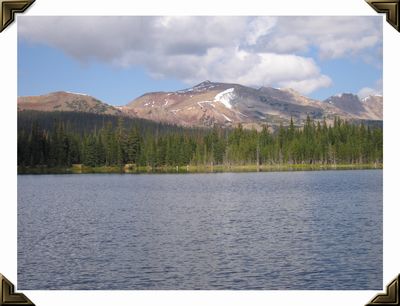 This is Zimmerman Lake. Notice the rough water. Not good for fishing dry flies, which was the order of the day. Mike and Doug never saw a rise while they were there. An approaching storm threatened to drive them off the mountain so they decided to return to Joe Wright Creek for more Greenbacks and Grayling. 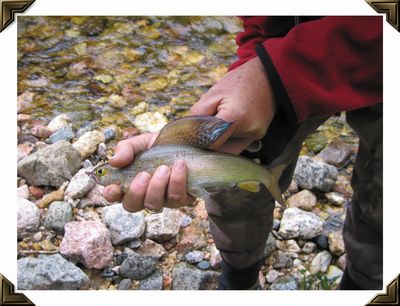 And, they were successful. Here is one of Joe Wright Creek's Grayling. 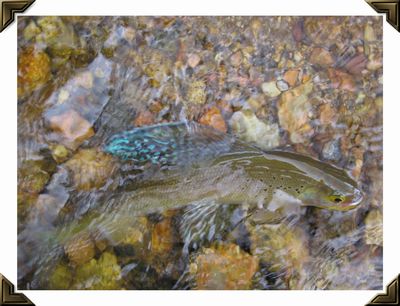 A great photo of a Joe Wright Creek Grayling. 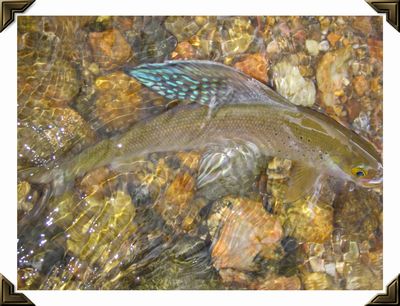 A great shot of the Grayling's beautiful dorsal fin. 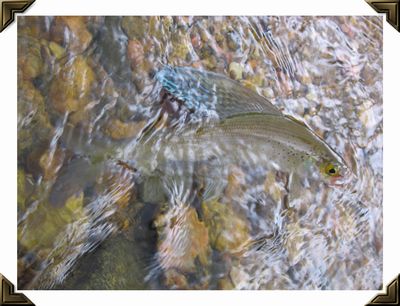 It has been said that Grayling have an unusual eye that detects small insects from a long distance but that they need reading glasses when they get close, often making repeated tries at a meal before capturing it. That may be the case in lakes but it wasn't the case on Joe Wright Creek where they hit small dry flies on the first try. 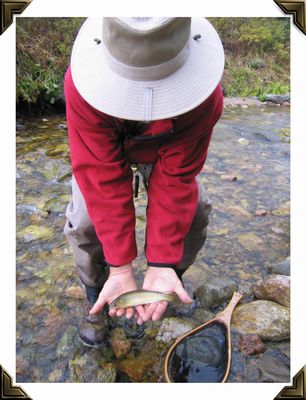 Doug Nauman with a Joe Wright Creek Greenback Cutthroat. 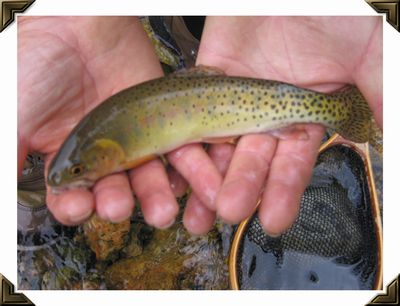 You certainly can see why they are called Greenback Cutthroat. 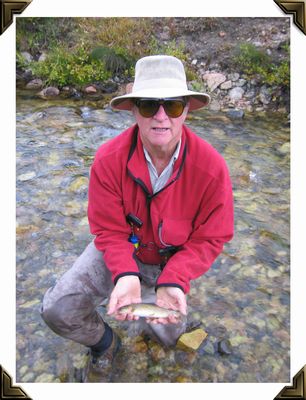 Doug with another Greenback. There are no photos of Mike even though he caught more fish than we did. The reason: he was the man with the camera. 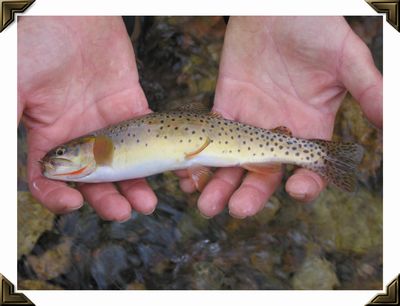 The last fish our fishing adventure in Colorado and what a wonderful adventure it was. Thanks Mike.
Warmwater Fly Tyer - by Ward Bean
© Copyright 2025 Ward Bean, Council Bluffs, IA, All rights reserved. © Copyright 2025 Ward Bean, Council Bluffs, IA, All rights reserved.
|